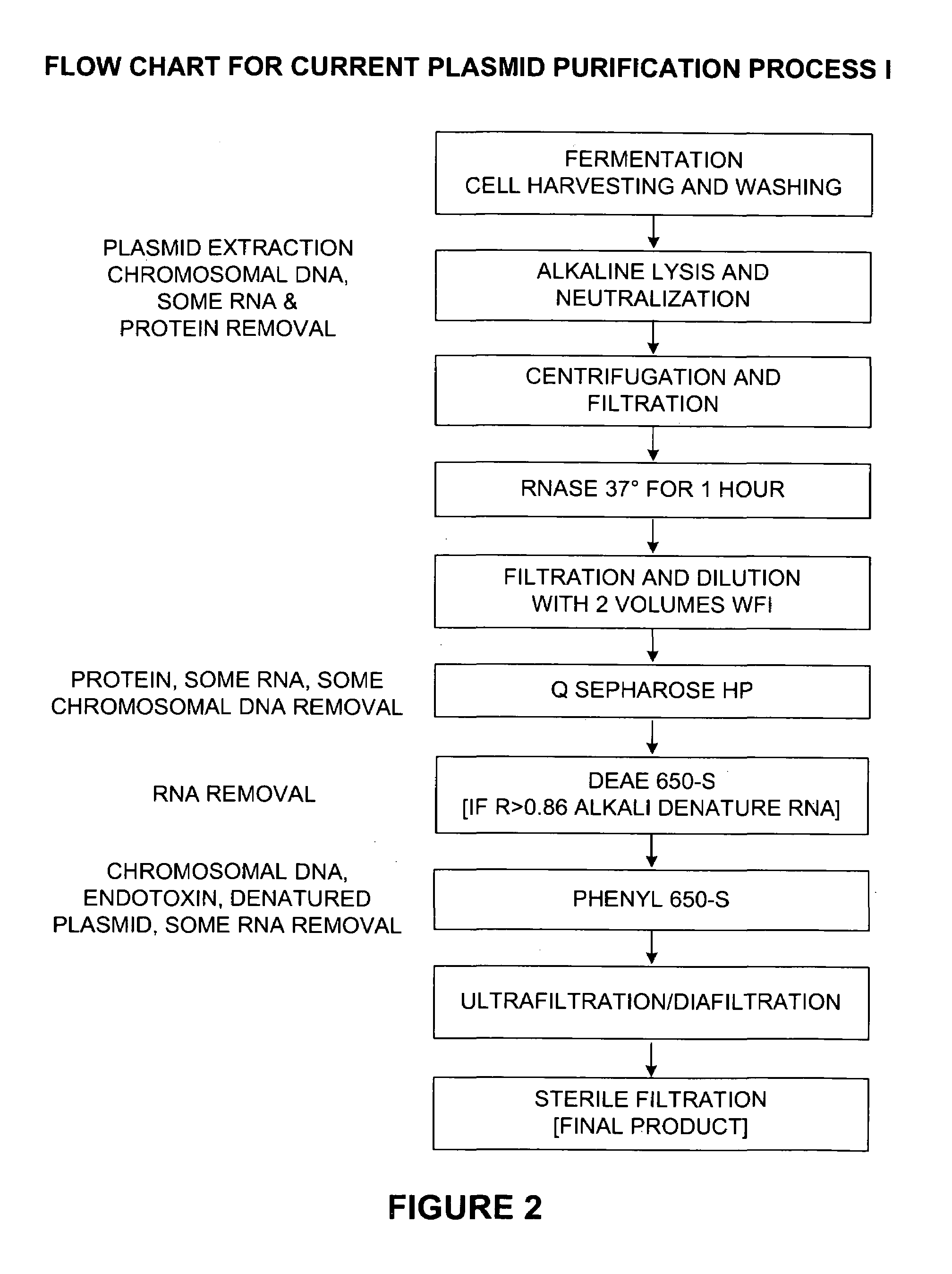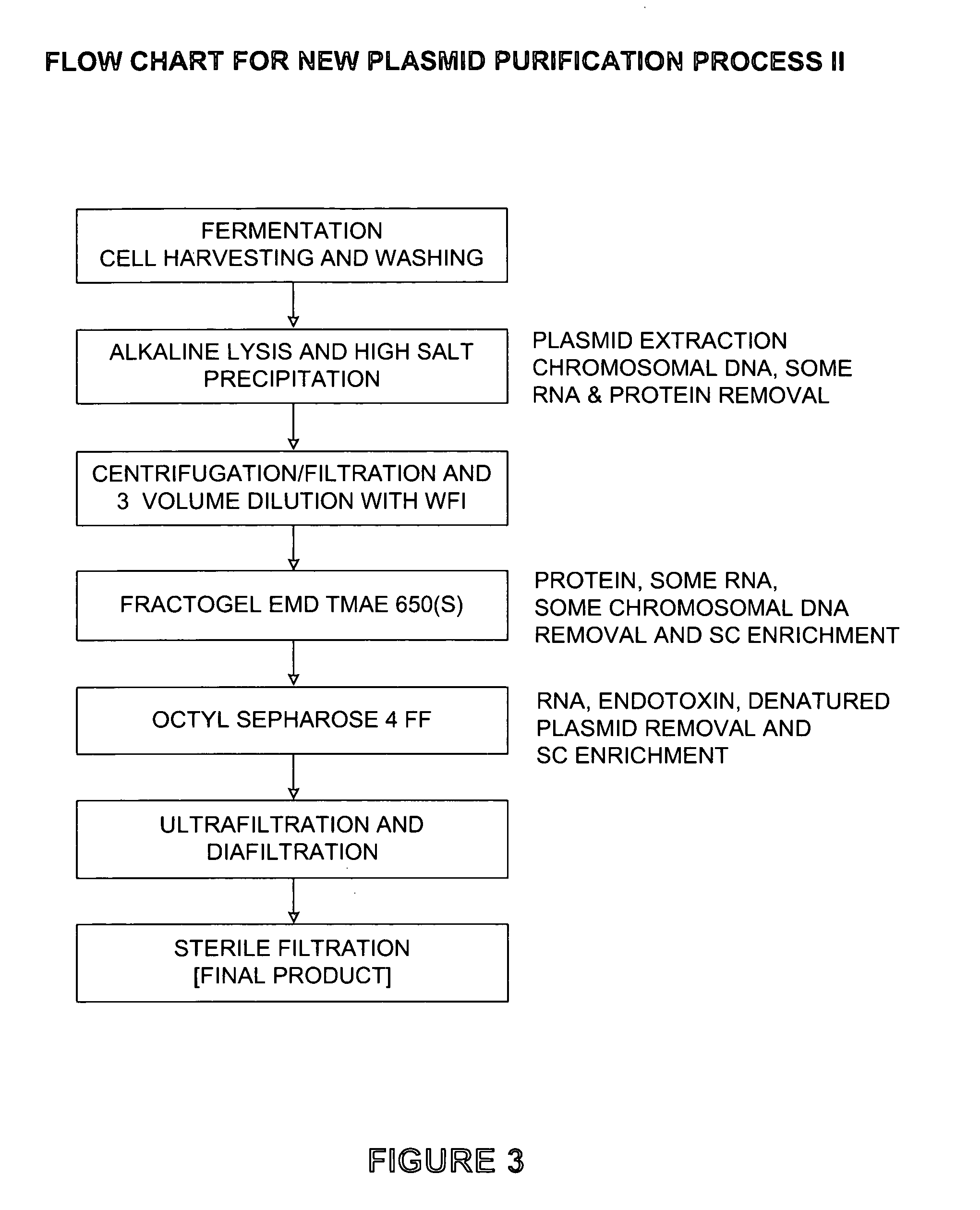Process and equipment for plasmid purification
a technology of plasmids and purification equipment, applied in the field of gene therapy, can solve the problems of unsuitable large-scale manufacturing, uncontrollable and manual operation, and unsuitable scale apparatuses and manual operations, and achieve the effect of low level of host chromosomal dna, low cost, and effective controllable operation
- Summary
- Abstract
- Description
- Claims
- Application Information
AI Technical Summary
Benefits of technology
Problems solved by technology
Method used
Image
Examples
example 1
Process I
[0060]The step-by-step methodology of Process I is outlined in FIG. 2.
[0061]Step 1 involves fermentation, cell harvesting, and washing. These are well known procedures that may be carried out in wide variety of ways known to those skilled in the art.
[0062]Step 2 involves alkaline lysis and neutralization. This step extracts plasmid, chromosomal DNA, RNA and protein. As explained in detail above, use of a high concentration of buffered salts is preferable.
[0063]Step 3 involves centrifugation and filtration. These also are well known techniques that may be performed in a variety of ways known to those skilled in the art.
[0064]Step 4 is RNase treatment at 37 degrees Celsius for one hour. This step may optionally be removed (as in Process II described in Example 2 below) by utilizing the preferred alkaline lysis and high salt agents described herein.
[0065]Step 5 involves filtration and dilution with 2 volumes of WFI. These are standard techniques that may easily be modified by ...
example 2
Process II
[0070]The steps of Process II are outlined in FIG. 3. Step (a) is fermentation of plasmid containing E. coli, cell harvesting, e.g. by centrifugation and washing and resuspending cells as in step 1 of Process I.
[0071]Step (b) is alkaline lysis (e.g., 1% SDS and 0.2N NaOH) and high salt precipitation to extract plasmid and remove chromosomal DNA and some RNA and protein. The high salt precipitation may involve adding 1M potassium acetate and 7M ammonium acetate (concentrations of both may be varied, with higher concentrations of ammonium acetate being better for RNA precipitation) and holding the temperature at 4 degrees Celsius for approximately 6 to 12 hours to precipitate RNA (times and temperatures may be varied; lower temperatures and longer times improve precipitation and incubation at 4 degrees Celsius provides a higher percentage of precipitation). The ability to precipitate RNA during neutralization of the alkaline lysate helps eliminate the need for RNase. The ace...
example 3
Unit Operations of the Invention
[0077]The unit operations in this invention are in-line static mixers, flow through lysis coils, and a chilled jacketed tank.
[0078]The cell paste, either from direct isolation from fermentation or thawed if frozen, was resuspended in TE buffer (50 mM Tris and 10 mM EDTA) by circulating the cell-buffer mixture through the in-line static mixer in a pump-around mode. The flow rate was specifically determined to be capable of effectively resuspending cells without breaking them.
[0079]The resuspended cells were mixed with the lysis solution (200 mM NaOH and 1% SDS) by flowing through the in-line static mixer, then entering the lysis coils for continuous lysis at a constant rate. The optimal flow rate to deliver cell-lysis solution mixture through the static mixer and lysis coils was determined to maximize the flow rate, minimize the shear force, and generate homogeneous mixture and desired molecule residence time.
[0080]The lysate was mixed with cold neutra...
PUM
| Property | Measurement | Unit |
|---|---|---|
| particle size | aaaaa | aaaaa |
| temperature | aaaaa | aaaaa |
| size | aaaaa | aaaaa |
Abstract
Description
Claims
Application Information
 Login to View More
Login to View More - R&D
- Intellectual Property
- Life Sciences
- Materials
- Tech Scout
- Unparalleled Data Quality
- Higher Quality Content
- 60% Fewer Hallucinations
Browse by: Latest US Patents, China's latest patents, Technical Efficacy Thesaurus, Application Domain, Technology Topic, Popular Technical Reports.
© 2025 PatSnap. All rights reserved.Legal|Privacy policy|Modern Slavery Act Transparency Statement|Sitemap|About US| Contact US: help@patsnap.com



